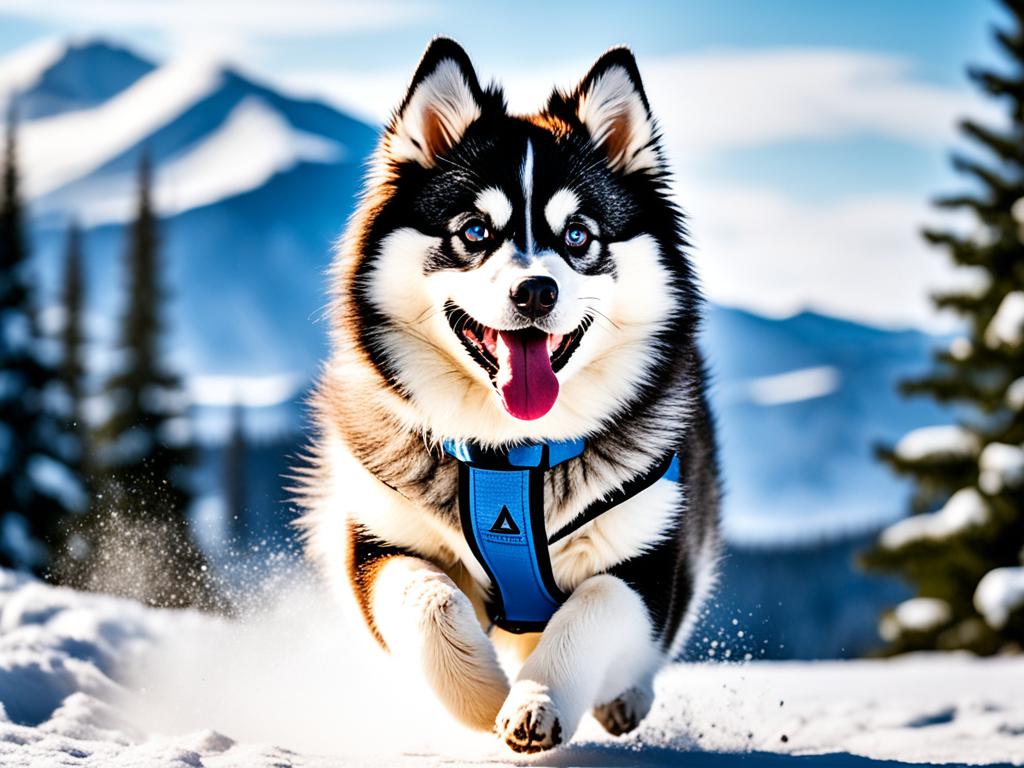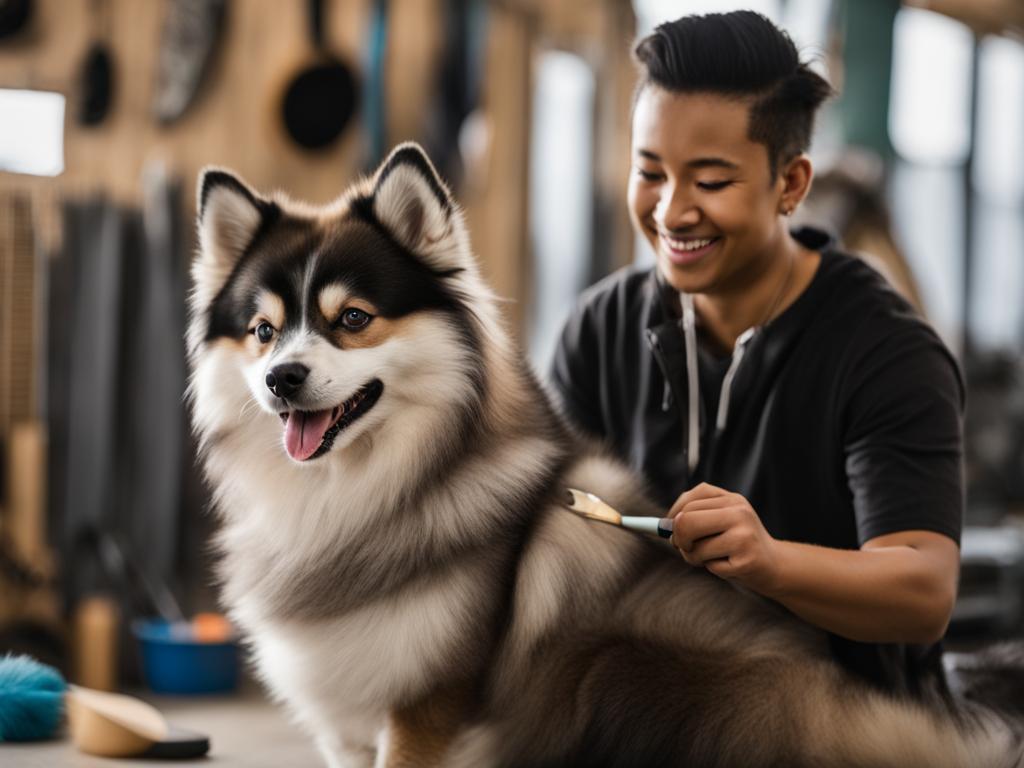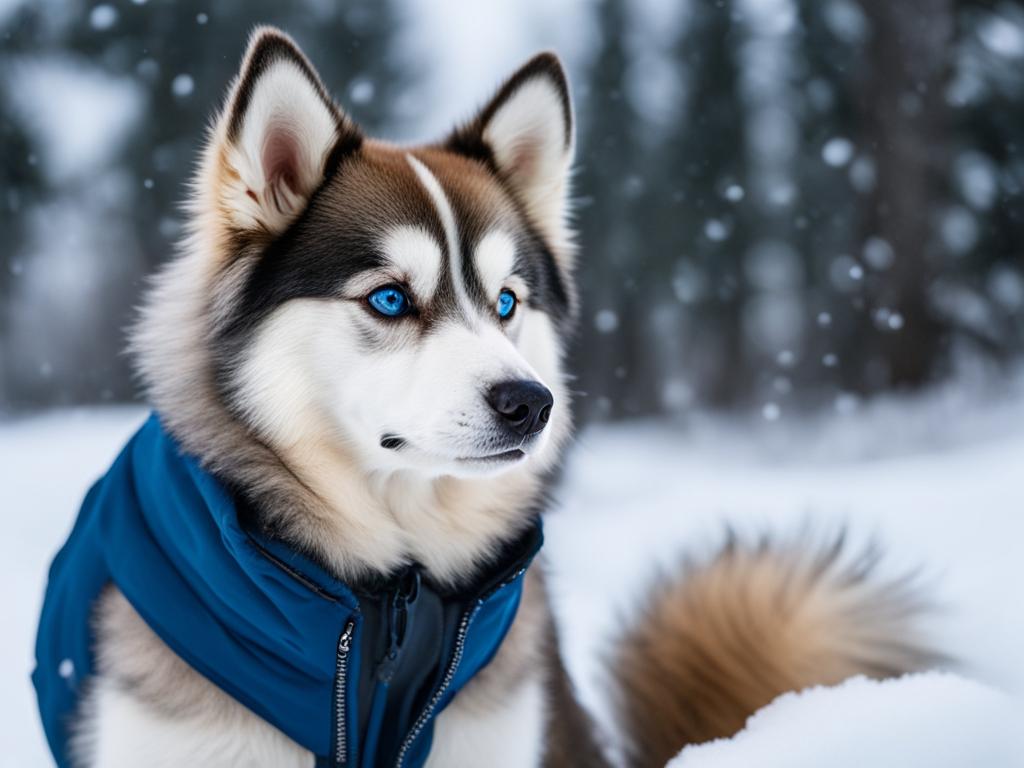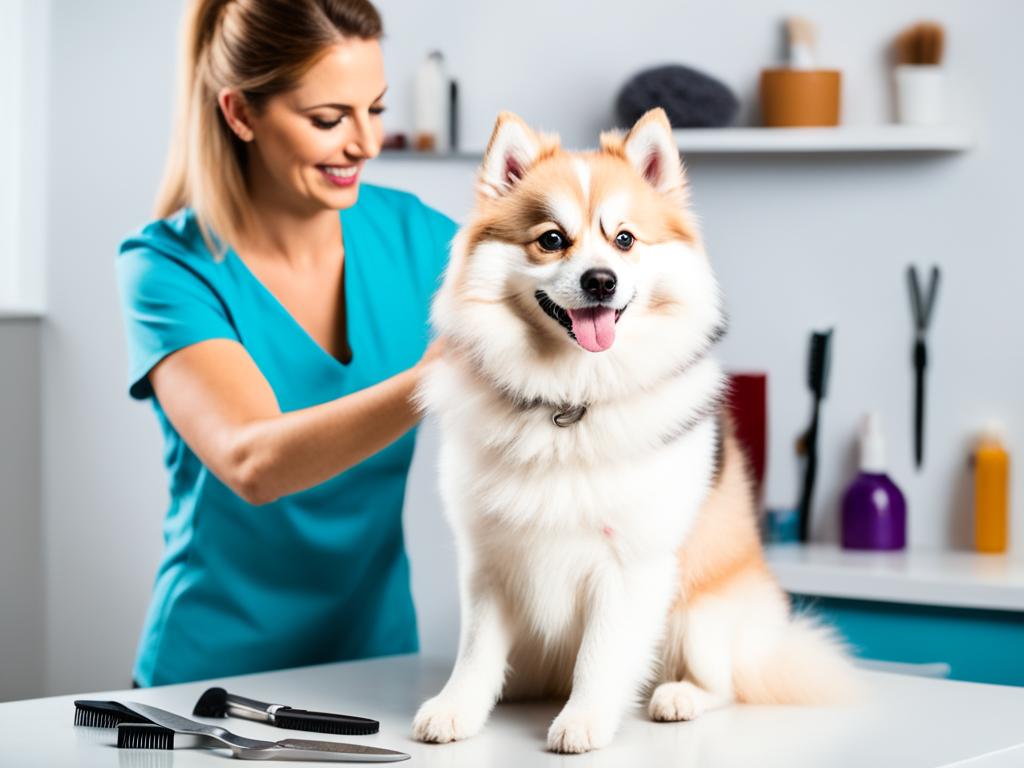Did you know that Pomskies showcase a wide range of coat varieties, including various types, colors, patterns, and textures? These unique hybrid dogs, a cross between the Pomeranian and Siberian Husky breeds, captivate pet owners with their diverse and stunning coats.
Key Takeaways:
- Pomskies exhibit a variety of coat types, colors, patterns, and textures.
- Their coat characteristics can differ significantly based on the genetics inherited from their parent breeds.
- Regular grooming and care are essential for maintaining the health and appearance of a Pomsky’s coat.
- Coat colors like black, gray, red, sable, and white are common, while less common options include blue, lilac, chocolate, cream, and fawn.
- When looking for a Pomsky with a specific coat variety, it’s crucial to research reputable breeders or adoption sources.
The Importance of Coat Care for Pomskies
Pomskies have a thick, double-coated fur that requires regular grooming to keep their coat healthy and reduce shedding. Proper coat care is essential for maintaining the Pomsky’s appearance and overall well-being. Here are some key aspects of Pomsky coat care:
Pomsky Grooming
Grooming plays a crucial role in keeping the Pomsky’s coat in optimal condition. Regular brushing not only helps to prevent matting, but it also stimulates the skin and enhances circulation, promoting a healthy coat. Brushing should be done at least two to three times a week, but during shedding seasons, daily brushing is recommended to manage the shedding process effectively.
Pomsky Shedding
Pomskies shed their undercoat twice a year, during spring and fall. This shedding process is known as “blowing coat.” It is important to be prepared for increased shedding during these periods and to provide extra grooming attention to remove loose fur and prevent tangling.
Pomsky Brushing
When brushing a Pomsky, it is best to use a slicker brush or a comb specifically designed for double-coated breeds. This type of brush will help to remove loose hair and detangle any knots without causing discomfort to the dog. It is important to be gentle and avoid pulling or tugging on the fur to avoid causing any skin irritation.
Pomsky Bathing
Bathing should be done as needed to keep the Pomsky clean and fresh. Use a mild dog shampoo formulated for sensitive skin to avoid drying out the coat and causing skin irritation. Regular bathing helps to remove dirt, dust, and any buildup of oils that can dull the coat’s shine.
Pomsky Coat Maintenance
In addition to regular brushing and bathing, there are other aspects of coat maintenance that should not be overlooked. These include:
- Regular cleaning of the ears to prevent infections
- Trimming of nails to keep them at a comfortable length
- Regular dental care, such as brushing the teeth or providing dental chews, to maintain oral health
Proper coat care, along with general grooming tasks, helps to keep the Pomsky healthy, comfortable, and looking their best.
Exercise Needs and its Impact on Pomsky Coats
Pomskies inherit the active and energetic nature of their parent breeds, the Pomeranian and Siberian Husky. Regular exercise is vital for keeping Pomskies happy and healthy, which in turn can contribute to the health and appearance of their coat.
Daily walks, playtime, and engaging activities like agility training can meet their exercise needs and provide mental stimulation, resulting in a well-maintained and vibrant coat.
- Physical Activity: Pomskies require a sufficient amount of physical activity to keep their energy levels in check and to prevent behavioral issues that may arise due to pent-up energy. Regular exercise helps in maintaining the muscle tone and overall body health of Pomskies, which can positively impact the quality of their coat.
- Mental Stimulation: In addition to physical exercise, providing Pomskies with mental stimulation is essential for their well-being. Engaging activities like puzzle toys, obedience training, and interactive play sessions can keep their minds active and prevent boredom. This mental engagement can indirectly contribute to the appearance of their coat.
- Bonding Time: Regular exercise sessions also provide an opportunity for Pomsky owners to bond with their furry companions. Spending quality time together during walks, playing fetch, or participating in agility training builds trust and strengthens the bond between owner and pet, resulting in a happier and healthier Pomsky.
Giving Your Pomsky Proper Exercise:
It’s important to tailor the exercise routine of your Pomsky to their size, age, and overall health. Here are some guidelines to consider:
- Start with short walks or play sessions and gradually increase the intensity and duration as your Pomsky builds stamina.
- Engage in activities that suit their energy level and natural instincts. For example, if your Pomsky has a strong prey drive, incorporate games like fetch or hide-and-seek.
- Consider the weather conditions. Pomskies have a thick coat that can make them sensitive to hot temperatures, so take precautions during hot weather and provide ample water breaks.
- Maintain a consistent exercise schedule to establish a routine and ensure your Pomsky gets the physical activity they need on a regular basis.

Health Considerations for Pomsky Coats
Pomskies are adorable dogs with unique coat varieties. However, it’s important to note that they can be prone to certain health conditions that may affect their coat. Taking care of their health is essential in ensuring a vibrant and well-maintained coat.
Dental Care
Like many small breeds, Pomskies are susceptible to dental problems. Proper dental care, including regular teeth brushing and professional cleanings, is crucial to maintain their oral health and prevent dental issues that could impact their coat quality.
Eye Health
Pomskies can inherit eye conditions from their parent breeds. Regular eye examinations by a veterinarian can help detect any issues early on and ensure proper treatment. Taking care of their eye health not only contributes to their overall well-being but also helps maintain the brilliance of their coat.
Joint Issues
Pomskies may develop joint issues, such as hip dysplasia or luxating patella, which can affect their mobility and impact their coat’s appearance. Keeping your Pomsky at a healthy weight, providing appropriate exercise, and monitoring their joint health can help prevent and manage these issues.
Hypothyroidism
Hypothyroidism is a condition that affects the thyroid gland and can cause a variety of health problems, including coat changes. Regular veterinary check-ups and monitoring your Pomsky’s thyroid levels are essential to catch and manage any potential thyroid issues.
To maintain your Pomsky’s overall health and the quality of their coat, it’s crucial to provide them with a balanced diet, regular exercise, and routine veterinary care. By addressing their specific health needs and taking preventive measures, you can ensure your Pomsky has a healthy and lustrous coat.
| Health Considerations | Common Conditions |
|---|---|
| Dental Care | Pomsky dental problems |
| Eye Health | Pomsky eye conditions |
| Joint Issues | Pomsky hip dysplasia, luxating patella |
| Hypothyroidism | Pomsky hypothyroidism |
Lifespan and Longevity of Pomsky Coats
Pomskies are known for their unique coat varieties, but how long can you expect their beautiful coats to last? The lifespan of a Pomsky generally falls between 12 to 15 years, with proper care and attention.
Ensuring the longevity of your Pomsky’s coat involves several key factors. A balanced diet is essential to provide the necessary nutrients for healthy hair growth. Consult your veterinarian for recommendations specific to your Pomsky’s dietary needs.
Regular exercise is also crucial for maintaining the overall health and appearance of your Pomsky’s coat. Keeping your furry friend active with daily walks and playtime can contribute to a shiny and lustrous coat.
Veterinary care plays a vital role in the longevity of your Pomsky’s coat. Regular check-ups, vaccinations, and preventive care can address any underlying health issues that may affect their coat. Your veterinarian can also provide expert guidance on specific grooming routines and products to keep your Pomsky’s coat in top condition.
By monitoring your Pomsky’s overall health and being proactive in their care, you can help ensure a long and healthy life for your beloved companion. With a well-cared-for Pomsky, you can enjoy the joy and beauty of their coat for many years to come.
Training and Socialization for Pomsky Coats
Effective training and socialization play a crucial role in not only shaping a Pomsky’s behavior but also maintaining the health and appearance of their coat. Pomskies are intelligent and responsive dogs, making them highly trainable with the right approach. Here are some key aspects to consider when training and socializing your Pomsky:
Positive Reinforcement Training
Pomskies respond best to positive reinforcement training methods. Reward-based training techniques, such as treats, praise, and play, can motivate and encourage desired behaviors in your Pomsky. This approach helps build a strong bond between you and your furry companion while promoting a well-behaved attitude and a healthy coat.
Early Socialization
Early socialization is important to expose your Pomsky to different people, animals, environments, and experiences. This helps prevent behavioral issues like aggression and anxiety later in life. By introducing your Pomsky to a variety of situations in a positive and controlled manner, you can help them develop confidence and a calm demeanor, which contributes to their overall well-being and a lustrous coat.
Mental Engagement
Pomskies are highly intelligent and energetic dogs that require mental stimulation to prevent boredom and destructive behavior. Engage your Pomsky in mental enrichment activities such as puzzle toys, obedience training, and interactive play. This mental engagement not only keeps them mentally sharp but also contributes to a happy and well-groomed coat.
Leash Training
Leash training is essential for a Pomsky’s safety and well-being. Teach your Pomsky to walk calmly on a leash using positive reinforcement techniques. This not only promotes good leash manners but also ensures that their coat stays free from tangles and mats caused by excessive pulling or dragging.
Crate Training
Crate training can provide a safe and comfortable space for your Pomsky, as well as aid in house training and preventing destructive behavior. Introduce the crate gradually, using positive reinforcement to create a positive association. A well-adjusted Pomsky with a well-maintained coat can benefit from the structure and security provided by crate training.
By incorporating positive reinforcement training, socialization, mental engagement, leash training, and crate training, you can help your Pomsky develop good behavior and maintain a healthy and beautiful coat.

| Training Tips | Socialization Tips |
|---|---|
|
|
Coat Colors and Patterns of Pomskies
Pomskies, the adorable crossbreed of Pomeranians and Siberian Huskies, can showcase a wide variety of coat colors and patterns. Their coat characteristics are influenced by their genetic makeup inherited from their parent breeds, resulting in unique and captivating appearances.
Coat Colors
Pomskies can be found in various coat colors, providing pet owners with a range of options to choose from. Some of the common coat colors in Pomskies include:
- Black: A rich, deep black that gives the Pomsky a sleek and elegant appearance.
- Gray: Shades of gray, ranging from light silver to dark charcoal, can add a touch of sophistication to the Pomsky’s coat.
- Red: Vibrant shades of red, from deep mahogany to bright copper, can make a Pomsky stand out with warmth and energy.
- Sable: Sable coat colors exhibit a mixture of black-tipped hairs on a lighter background, creating a stunning blend of hues.
- White: A crisp and pristine white coat can give a Pomsky a striking and angelic appearance.
These colors can be combined to create unique and eye-catching coat variations in the Pomsky breed.
Coat Patterns and Markings
In addition to coat colors, Pomskies can exhibit various patterns and markings, adding further complexity to their coat aesthetics. Some common patterns and markings found in Pomskies include:
- Bi-color: Featuring two clearly defined colors on their coat, creating a distinct contrast.
- Tri-color: Showcasing three different coat colors, often arranged in specific patterns.
- Mismarked: These Pomskies have unconventional patterns or markings that deviate from standard breed expectations.
- Masks: Some Pomskies may display a mask-like pattern surrounding their eyes, enhancing their facial features.
- Merle: The merle pattern consists of irregular patches or spots on a solid-colored coat, resulting in a captivating and unique appearance.
The specific coat pattern of a Pomsky can vary, and each individual showcases their own distinctive and beautiful markings.
| Coat Color | Coat Pattern |
|---|---|
| Black | Mismarked |
| Gray | Bi-color |
| Red | Tri-color |
| Sable | Masks |
| White | Merle |
Table: Examples of Pomsky Coat Colors and Patterns
As displayed in the table above, certain coat colors are commonly associated with specific patterns, resulting in a dazzling array of coat variations in the Pomsky breed.
In the next section, we will explore some of the less common coat colors that can be found in Pomskies, adding even more diversity to this remarkable breed.
Less Common Coat Colors of Pomskies
In addition to the common coat colors, Pomskies also come in some less common and unique options. These coat colors add a touch of exclusivity and variety to the already charming breed. Here are some of the less common coat colors that you may find in Pomskies:
- Pomsky Blue Coat: This stunning coat color resembles the beautiful blue hues seen in certain dog breeds. It adds a touch of elegance and sophistication to the Pomsky’s appearance, making them truly stand out.
- Pomsky Lilac Coat: The lilac coat color is a delicate and soft shade of lavender. It gives Pomskies a gentle and ethereal look, making them even more adorable and captivating.
- Pomsky Chocolate Coat: The rich and deep brown color of a chocolate coat gives Pomskies a warm and cozy appearance. It is a less common yet beautiful option that showcases their unique charm.
- Pomsky Cream Coat: A cream-colored coat is a lighter shade of white, exuding elegance and purity. This less common coat color accentuates the Pomsky’s adorable features, making them irresistibly cute.
- Pomsky Fawn Coat: The fawn coat color is a lovely blend of tans and light browns, reminiscent of warm earthy tones. It adds a touch of natural beauty to the Pomsky’s coat, enhancing their overall appeal.
While these less common coat colors may be more challenging to find, they offer a unique and striking alternative to the more commonly seen coat varieties. Each of these colors brings its own distinct charm and personality to the Pomsky breed, making them even more captivating and lovable.

Coat Care Tips for Pomskies
Proper coat care is essential for keeping your Pomsky’s coat healthy and looking its best. Here are some tips to help you maintain your Pomsky’s coat:
Brushing Tips
Regular brushing is crucial for keeping your Pomsky’s coat free from tangles, mats, and excessive shedding. Use a slicker brush or comb with fine teeth to gently remove loose fur and prevent matting. Brush in the direction of hair growth, paying extra attention to areas prone to tangling, such as behind the ears and under the armpits.
Bathing Tips
When it comes to bathing your Pomsky, it’s important to strike the right balance. Over-bathing can strip their coat of essential oils, while under-bathing can lead to dirt buildup and an unpleasant odor. Aim to bathe your Pomsky every 4-6 weeks or as needed. Use a gentle, dog-specific shampoo, and thoroughly rinse and dry your Pomsky’s coat to prevent dampness and potential skin issues.
Grooming Tips
In addition to brushing and bathing, regular grooming tasks are necessary for maintaining your Pomsky’s coat. This includes cleaning their ears to prevent infections, trimming their nails to a safe length, and maintaining their dental health through regular brushing or dental treats. Consulting a professional groomer can also help keep your Pomsky looking their best.
Overall Health and Diet
The overall health and diet of your Pomsky play a vital role in the condition of their coat. A balanced diet that meets their nutritional needs can promote a healthy coat. Ensure your Pomsky has access to fresh water at all times and feed them high-quality dog food appropriate for their age, size, and activity level. Regular exercise, mental stimulation, and annual veterinary check-ups are also important for maintaining your Pomsky’s overall health and coat quality.
Tips Summary:
- Brush your Pomsky’s coat regularly to prevent tangles and mats.
- Bathe your Pomsky every 4-6 weeks with a gentle shampoo.
- Perform regular grooming tasks like ear cleaning, nail trimming, and dental care.
- Ensure your Pomsky has a balanced diet and regular exercise.
- Schedule annual veterinary check-ups to monitor your Pomsky’s health and coat condition.
By following these coat care tips, you can keep your Pomsky’s coat healthy, shiny, and beautiful!

Finding and Owning a Pomsky with the Coat Variety of Your Choice
If you have your heart set on owning a Pomsky with a specific coat variety, it’s important to conduct thorough research and find a reputable breeder or adoption option. Pomskies with unique coat colors and patterns may be more challenging to find and may come at a higher cost.
When searching for your dream Pomsky, consider factors like availability, prices, and the reputation of breeders or adoption sources. A reputable breeder will provide you with detailed information about the coat variety, including its characteristics and any specific care requirements. They will also ensure proper health checks, vaccinations, and a clean living environment for the puppies.
If you prefer adoption, there are rescue organizations and shelters that occasionally have Pomskies available for adoption. Adopting a Pomsky not only gives you the opportunity to provide a loving home to a dog in need but also offers a chance to find unique coat varieties.
Remember that Pomskies with rarer coat colors and patterns may have a higher demand, making them less readily available. Be patient and stay in contact with reputable breeders or adoption sources. With perseverance, you can find the perfect Pomsky with the coat variety that matches your preference.
FAQ
What are the different coat varieties of Pomskies?
Pomskies can have various coat types, colors, patterns, and textures, which can vary widely based on their genetic makeup inherited from their Pomeranian and Siberian Husky parents.
How should I care for the coat of my Pomsky?
Regular brushing, appropriate bathing, and addressing specific grooming needs are important for maintaining the Pomsky’s coat. Additionally, a balanced diet, exercise, and overall health monitoring contribute to a well-maintained coat.
How does exercise impact the coat of a Pomsky?
Regular exercise, including daily walks, playtime, and engaging activities, can keep Pomskies happy and healthy, contributing to the health and appearance of their coat.
What health considerations should I keep in mind for my Pomsky’s coat?
Pomskies can be prone to certain health conditions, including dental problems, eye conditions, joint issues, and hypothyroidism, which can affect their coat. Regular veterinary care, good oral hygiene, eye examinations, a balanced diet, and appropriate exercise are important for maintaining their overall health and coat.
How long do Pomskies generally live, and how can I ensure the health and appearance of their coat?
Pomskies have a lifespan of 12 to 15 years. Providing a balanced diet, regular exercise, proper veterinary care, and monitoring their overall health can contribute to their longevity and the appearance of their coat.
How can I train and socialize my Pomsky to maintain a healthy coat?
Training a Pomsky is essential not only for their behavior but also for their overall well-being, including the maintenance of their coat. Pomskies respond well to positive reinforcement and benefit from early socialization and mental engagement activities.
What are the different coat colors and patterns of Pomskies?
Pomskies can come in a wide range of coat colors, including black, gray, red, sable, and white. These colors can be combined with various patterns and markings, such as bi-color, tri-color, mismarked, masks, and merle.
Are there any less common coat colors for Pomskies?
Yes, some less common coat colors for Pomskies include blue, lilac, chocolate, cream, and fawn. While these colors may be more difficult to find, they can add uniqueness and variety to the Pomsky’s coat.
What are some tips for properly caring for the coat of a Pomsky?
Regular brushing, appropriate bathing, and addressing any specific grooming needs are essential for proper coat care in Pomskies. Additionally, paying attention to their diet, exercise, and overall health can contribute to a well-maintained coat.
How can I find and own a Pomsky with the specific coat variety of my choice?
To find a Pomsky with a specific coat variety, it’s important to do thorough research and find a reputable breeder or adoption option. Unique coat colors and patterns may be more difficult to find and may come at a higher cost. Consider factors like availability, prices, and the reputation of breeders or adoption sources when choosing a Pomsky with the desired coat variety.

Leave a Reply